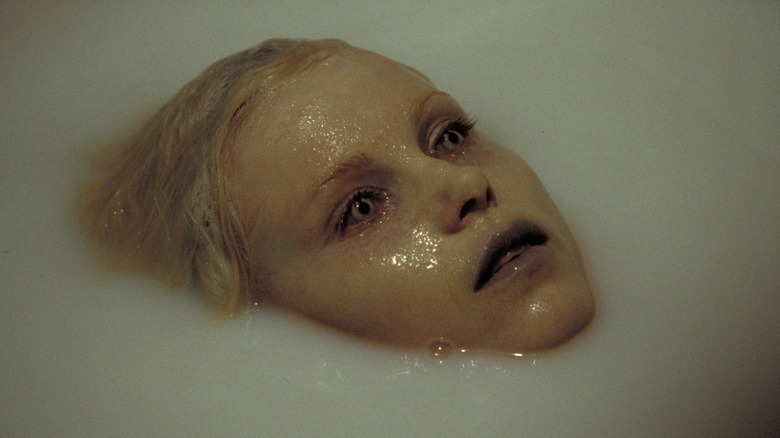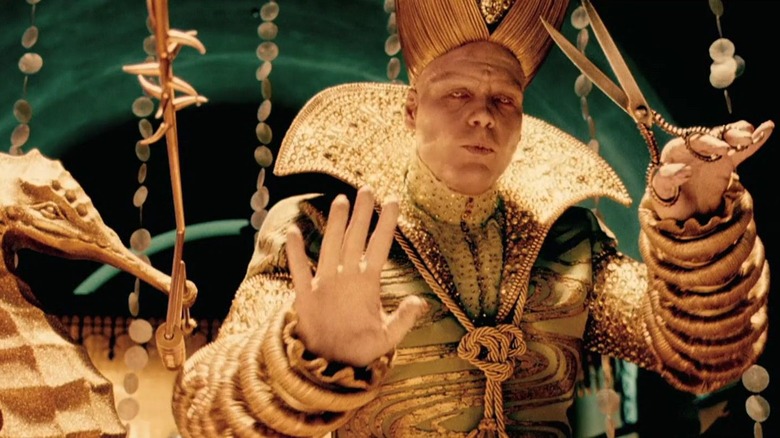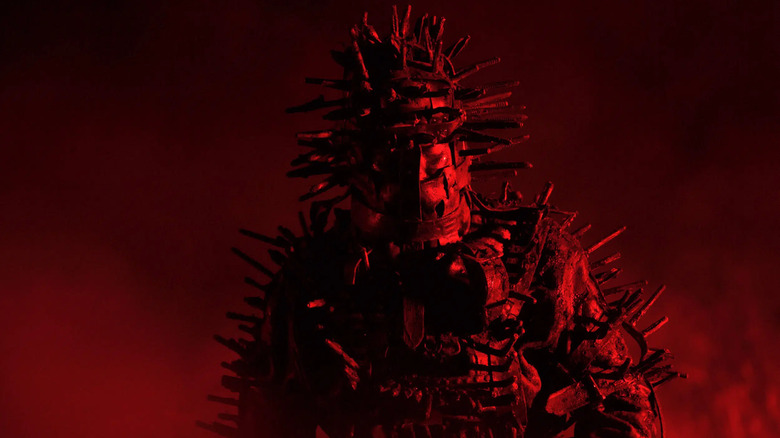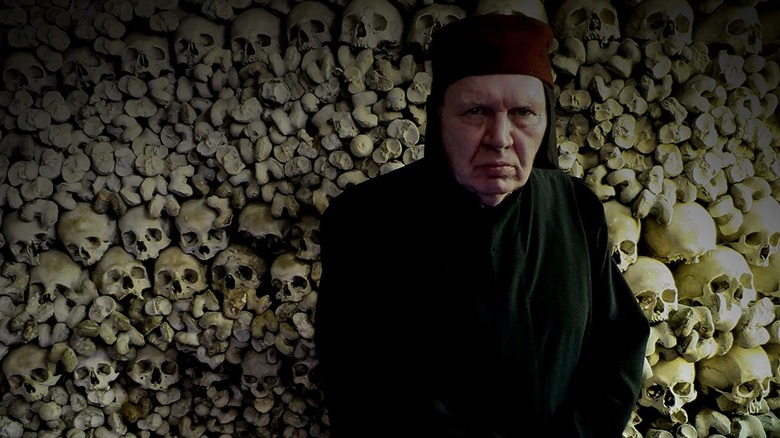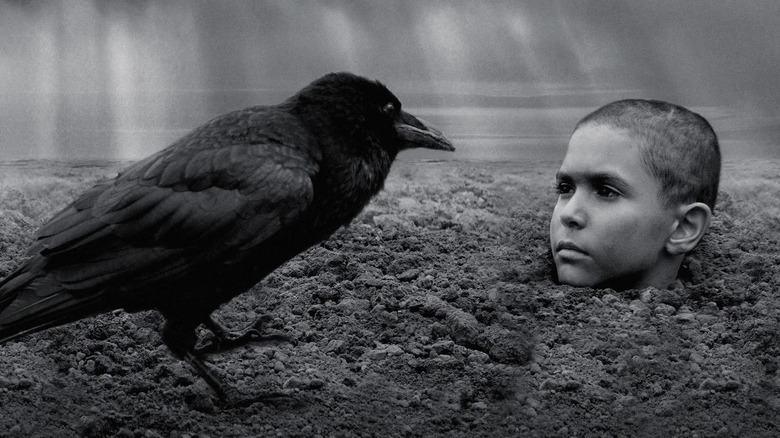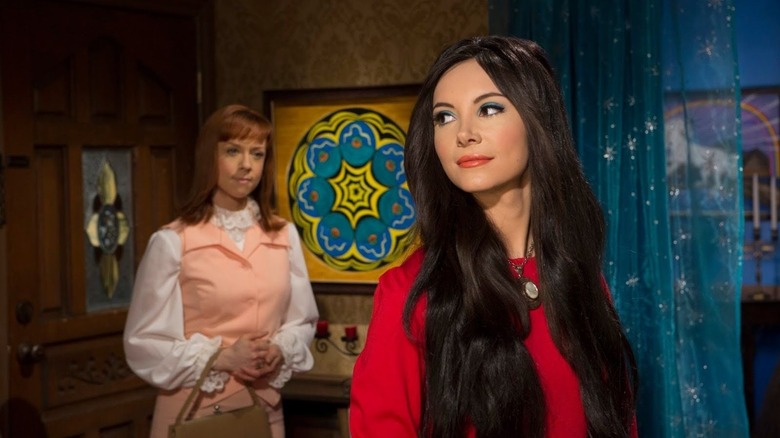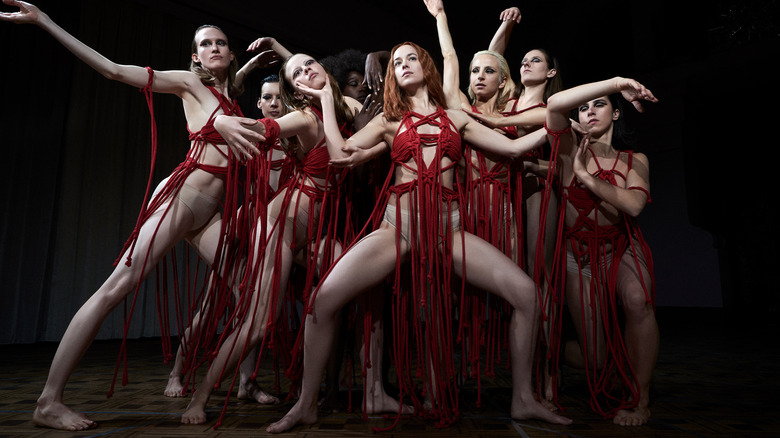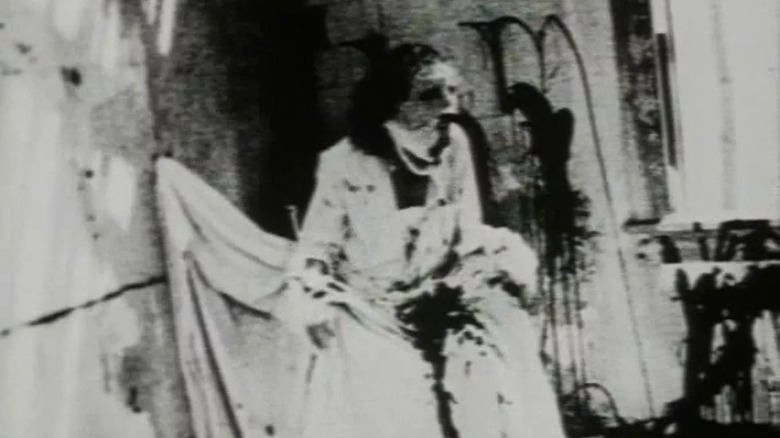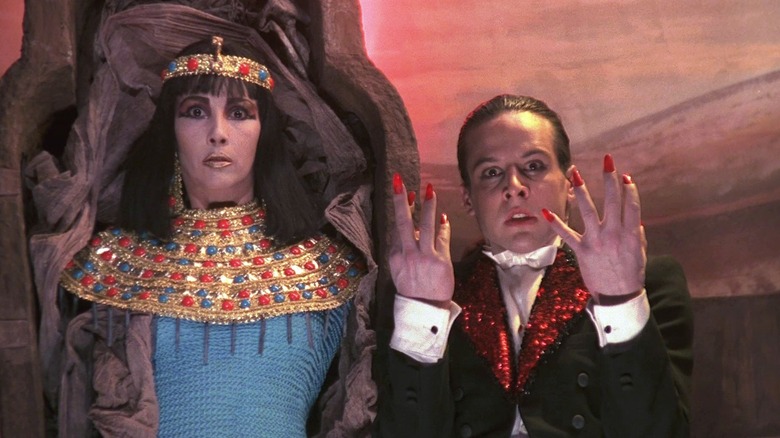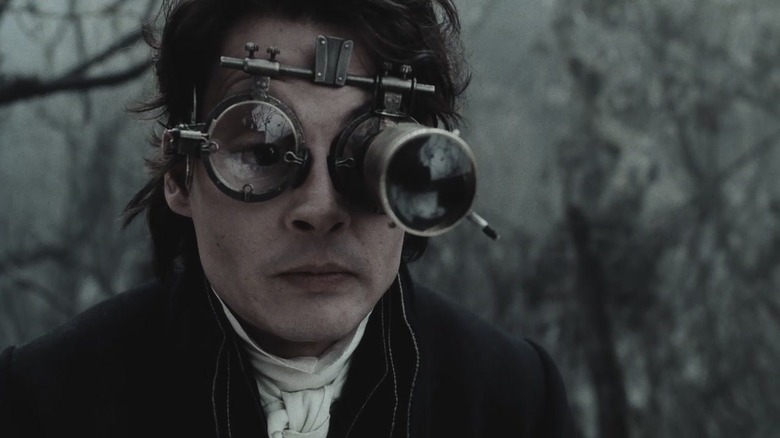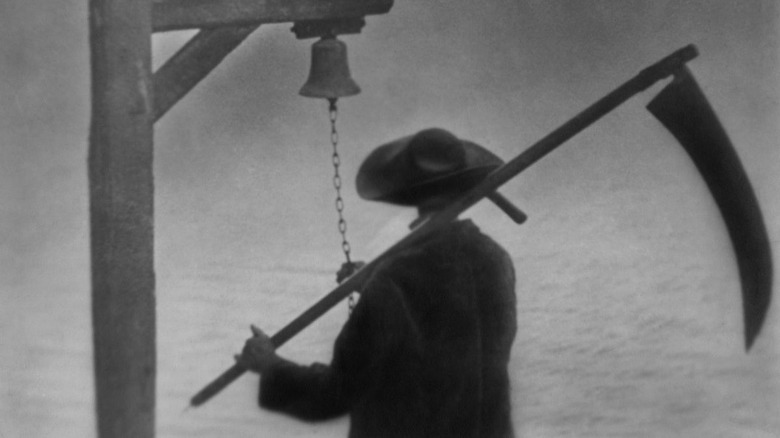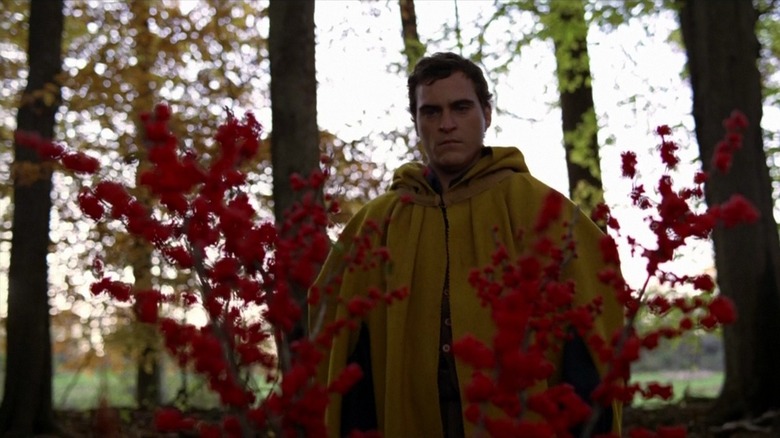Horror Movies That Are Just As Beautiful As They Are Terrifying
Horror, it has been said, serves as an ongoing, and ultimately never-ending exploration of humankind's innate fear of death. No matter the medium, the genre allows audiences to sit in a safe environment and explore their own mortality, so easily snatched away by a woods-dwelling ogre in a hockey mask. Horror, even when accompanied by raunchy, gory, exploitation movie glee, is the most philosophical of genres, staring the Grim Reaper right in its eye sockets, and coming to a deep understanding that death will always be an important part of our existence.
Certain filmmakers understand the morbid poetry the contemplation brings and have constructed beautifully alluring visuals to accompany their terrifying stories. Some might say death is weirdly beautiful. As Charles Baudelaire once wrote, "I hate all tombs, and testaments, and wills: I want no human tears; I'd like it more, That ravens could attack me with their bills, To broach my carcass of its living gore."
In the spirit of Baudelaire, here are 10 movies that are as beautiful as they are terrifying.
The Cell (2000)
Tarsem Singh was known as the director of striking and award-winning commercials and music videos — notably, R.E.M.'s "Losing My Religion" — prior to his feature debut with "The Cell" in 2000. "The Cell" is about a psychologist (Jennifer Lopez) who has access to a device that allows her to project her consciousness into the minds of others. The device comes in handy when an apprehended serial killer (Vincent D'Onofrio) falls into a coma, and the cops need to locate one of his still-living kidnap victims. Lopez has to enter his mind, figure out his psychology, and locate his victim.
The problem is: The subconscious mind of a serial killer is a swirling, MTV-infected nightmare full of abuse, demons, dismembered horses, ethereal ghostly women, corpses reanimated with machinery, and torture devices not seen since the Middle Ages. And when one is a mere disembodied consciousness, the torture can extend far past the point of what is possible for the human body to withstand. "The Cell" is a legitimate phantasmagoria of horror, an illuminated manuscript of pain. No film has production design quite like this, leaving brand-new nightmare images to carry with you forever.
Mandy (2018)
What if a horror movie took place inside a death metal album cover? That is the question posited by Panos Cosmatos' 2018 cult hit "Mandy," a revenge film that features a burned-out acid-laced Christian cult, a gang of motorcycle cenobites, and an axe that wouldn't feel out of place on the Klingon homeworld.
In "Mandy," Nicolas Cage and Andrea Riseborough play a warm, sweet, loving couple, Red and Mandy, who are at peace in the wood with their books and their heavy metal albums. Using the aid of a gang of knife-encrusted demonic gearhead monsters, the above-mentioned cult, led by Linus Roache, kidnaps Mandy in the hopes of indoctrinating her. Even more horrible things happen after that — including an unexpected visit from the Cheddar Goblin — and Red ends up having to smelt his own axe and set out on a quest of blood revenge. Calm in its first half and blisteringly insane in its second, the smeared heavy metal visuals of "Mandy" are a rock opera unto themselves.
Hagazussa: A Heathen's Curse (2017)
Lukas Feigelfeld's "Hagazussa: A Heathen's Curse" was one of the best films of 2017, and it may be considered a new classic of folk horror. Set in the Swiss Alps in sometime in the 15th century, "Hagazussa" tells the story of a young woman (Aleksandra Cwen) and her utterly harrowing experience of religious rejection, abuse, and sexual persecution by anyone who happens to cross her path, from distant neighbors to her own disease-riddled mother. While she remains distant from most people, a cloud of anti-Semitism and sexism hangs over everything, of which Cwen will repeatedly bear the brunt. The film climaxes in a particularly shocking act of violence.
"Hagazussa" is set largely in the wilderness, and cinematographer Mariel Baqueiro makes the entire Earth look like a hazy, inhospitable place knotted with roots and strands of unknowable plant material. The natural world, it seems, is specifically designed to reduce once-living, vibrant beings into pustule-encrusted corpses, and, eventually, a mere pile of moss-coated bones. The firelight is not warm and inviting, but repellent and wicked. This is a beautiful world you do not want to inhabit.
The Painted Bird (2019)
Based on the book by Jerzy Kosiński, Václav Marhoul's 2019 misery fest "The Painted Bird" is one of the bleakest films you might encounter. Set somewhere in rural Eastern Europe right at the outbreak of World War II, "The Painted Bird" follows the misadventures of a young boy (Petr Kotlár) as the world repeatedly grinds his face into the dirt. His caretaker dies, he accidentally burns down his own home, he is abused by every adult he sees and bears witness to acts of violence no human ought to see. He learns that if one smears paint on a bird, the other birds in its flock will peck it to death. Stained by the spirit of the war, the entire countryside has become, even from a distance, something akin to hell.
Vladimír Smutný's shimmering black-and-white photography is museum-worthy, and the hazy light — light that feels like it's weighing down the characters — denotes that life and color are gone from this world. The visuals are breathtaking, even as the pain and suffering mounts. There is no levity or joy or catharsis to be had in "The Painted Bird," and there is certainly something exhilarating about that.
The Love Witch (2016)
Director, producer, writer, editor, production designer, costume designer, and composer Anna Biller clearly loves chintzy, overdesigned Euro-sleaze horror movies of the late 1960s. Her 2016 film "The Love Witch" is one of the more authentic B-movie re-creations to come out of the neo-grindhouse movement. The quality of the light, the flatly delivered dialogue, the makeup, the music, the use of sex and nudity ... with only the smallest of adjustments, "The Love Witch" could be released in theaters in 1969. Cinematographer M. David Mullen knew what he was doing.
The story is a retro free-love parable. A witch (Samantha Robinson) loves freely and dreams of having a husband. She has sex on her terms, and, true to the title, men are constantly falling in love with her. This can be a problem when she doesn't care enough to keep them around. The thrills are very arch, the horror subdued, colorful, almost campy. It's a delightfully stylized, sexy little romp that fans of shlock and Italian horror can enthusiastically imbibe.
Suspiria (1977 & 2018)
Dario Argento's 1977 film "Suspiria" remains one of the best horror films ever made, despite the film making very little logical sense. Set in a German dance academy, a young aspiring ballerina (Jessica Harper) finds that witches run the school and are up to ... well, it's definitely sinister. The fireworks colors, overstuffed production design, cinematography by Luciano Tovoli, and unique kills — someone's chest is carved open to make a stab to the heart visibly clear — make "Suspiria" a punch to the eyeballs, even if the brain is a little discombobulated.
Just as effective and just as terrifyingly gorgeous is Luca Guadagnino's 2018 remake, which takes the same premise and setting, but expands, quite fascinatingly, into local German politics in the late 1970s. It's one of the only horror films to make reference to the Baader–Meinhof Group. Less colorful, but more atmospheric and textured, the photography, by Sayombhu Mukdeeprom, the regular cinematographer of Apichatpong Weerasethakul, is second to none.
Begotten (1989)
E. Elias Merhige's 1989 experimental film "Begotten" begins with an extended sequence of a masked figure in a rundown hovel, seemingly unable to control its limbs, steadily slicing out its own internal organs with a straight razor. This is God (Brian Salzberg). He dies. From his remains springs a masked nature figure. This is Mother Earth (Donna Dempsey). Using the corpse, Mother Earth becomes impregnated with a child. It is born an adult, but also cannot control its limbs and must be dragged around on a rope. This is Son of Earth (Stephen Charles Barry). When the ur-deities encounter mysterious robed figures, they are attacked and destroyed. God is dead. Nature is dead. Our connection to the natural world is dead. Lost in a present that never stops passing. Like a candle burning away the darkness, life is flesh on bone convulsing above the ground.
Filmed with no dialogue, "Begotten" was shot on grainy, scratched 16mm film, making the film look impossibly ancient. "Begotten" is the rare film that looks like it was shot by the very antediluvian entities it is about. It is a formative experience that remains at a distance, and yet so very close to something abstract and primal inside of humankind.
Santa Sangre (1989)
As a young man, Chilean auteur Alejandro Jodorowsky sought to enter the arts and change the world. It is a point of envy that he was able to do so. Jodorowsky had been making films and theater since the 1950s, and he burst onto the scene in 1970 with the release of his film "El Topo," the first proper midnight movie. (A New York exhibitor couldn't sell tickets during daylight hours, so he played it at midnight, attracting huge crowds; a phenomenon was born.) Jodorowsky chased "El Topo" with "The Holy Mountain" in 1973, one of the largest and most ambitious art films ever made. In 1989, Jodorowsky, tapping into his youth as a circus performer, made "Santa Sangre," a surrealist Freudian nightmare that plays like "Psycho" by way of Pleasure Island in "Pinocchio."
"Santa Sangre," replete with circus imagery, blood, knives, and violence, tells the story of a young man (Axel Jodorowsky) who alternately absorbs the influence of his gruff, tattooed, knife-throwing father, and his mother, who has founded a Christlike cult around an armless martyr and an impluvium of human blood. When his mother becomes an armless martyr herself, he will serve as her arms as part of a surreal pantomime performance.
No one can stuff a frame with dazzling visual information like Jodorowsky, and no one will leave "Santa Sangre" without being terrifyingly dazzled.
Sleepy Hollow (1999)
In its ever-so-finite wisdom, Paramount Pictures elected to release Tim Burton's "Sleepy Hollow" in mid-November 1999. With its spookhouse tone, jack-o-lantern imagery, ghostly story, and terrifying Headless Horseman, "Sleepy Hollow" most certainly needed to be released in time for Halloween. Based on the Washington Irving story, "Sleepy Hollow" reimagined Ichabod Crane (Johnny Depp) as a curious and cowardly police detective who uses novel scientific forensics to catch perpetrators. In Sleepy Hollow, however, his science comes up short when he realizes a headless assassin is aiding an old town rivalry in playing itself out.
Cinematographer Emmanuel Lubezki has never done finer work, making Sleepy Hollow into a gorgeous gray wasteland wherein the only thing to have any light is the young Katrina Van Tassel (Christina Ricci), and the only things to have color are her pink chalk, used for casting witch's spells, and the red, red blood that spurts out of the mounting number of corpses. An homage to Hammer Horror movies (including a cameo from Christopher Lee), "Sleepy Hollow" is a haunted house picture of the highest order, and it should be recognized as the Halloween classic it is.
Vampyr (1932)
It takes a certain kind of eye to make a film accurately seem like a dream, and Carl Theodor Dreyer had that talent in spades when it came to making his 1932 classic, "Vampyr." The film follows no recognizable logic; the story seems to drift in and out of consciousness; and the characters all seem to be in a constant state of fear, even when merely walking along a very long trail to a remote castle in the woods. Death hangs over everything, though it's hard to say why. The image of a farmer wielding a scythe might have something to do with it.
In "Vampyr," a lonely traveler spends the night in an inn. An old man appears in his room and gives him a box. It is not to be opened until the old man dies. The traveler treks out into the wilderness and finds a castle where shadows dance and defy the people they are attached to. The traveler will require a blood transfusion. He later sees himself being buried ... buried alive? Or has his spirit left his body? And now a young woman has been kidnapped? What is going on?
A dream is going on, and Dreyer's camera (handled by Rudolph Maté) shapes light and scenario in such a way that the glittering world feels slightly askew. A little too evenly lit. A place where shadows can detach. Is it a dream or a nightmare?
The Village (2004)
In 2004, M. Night Shyamalan's "The Village" was something of a disappointment. Audiences had already come to expect "twist" endings from Shyamalan, and many felt let down by a somewhat predictable reveal at the head of the film's third act. The years have been kind to "The Village," however, to the point where /Film counted it the second best of the director's films. However one might feel about the story or the twist, one cannot deny the overwhelming visual power of Roger Deakin's amazing photography, and Shyamalan's uncanny use of color.
The citizens of a remote, primitive village, sometime in the 19th century, wear cloaks of yellow to scare off a mysterious species of monsters referred to only as Those We Don't Speak Of. The village's entire ecosystem revolves around the prevention of attack. The monsters keep everyone within a very limited area, unable to venture beyond the woods. Someone will have to, however, when a young child becomes very ill and will require medicine. Bryce Dallas Howard plays a young woman with failing eyesight who must venture into the woods to face off against the creatures.
Add to the eerie monsters and gorgeous colors James Newton Howard's ethereal score, and you have something plenty scary.
